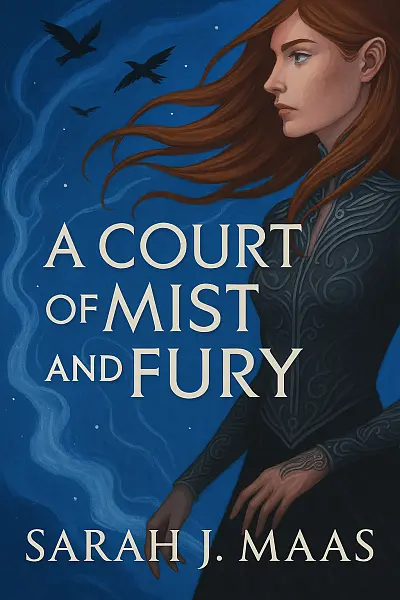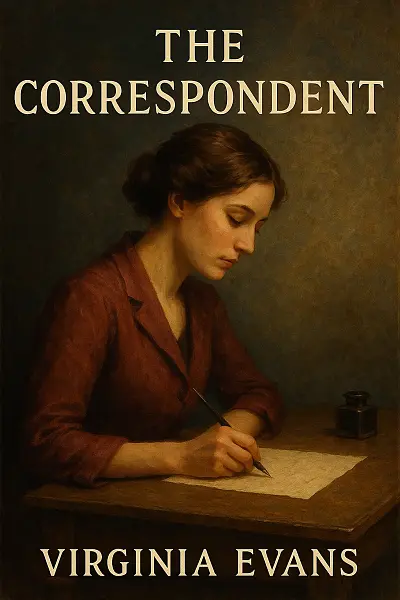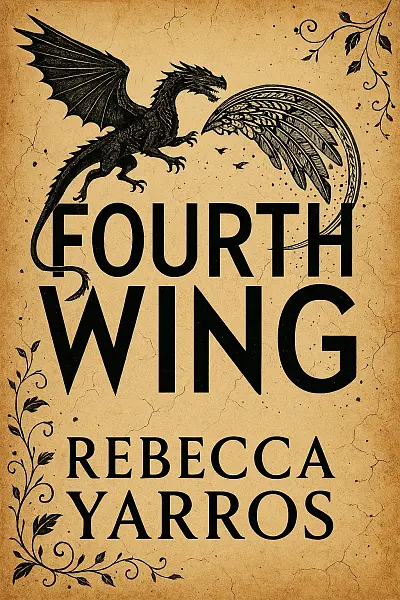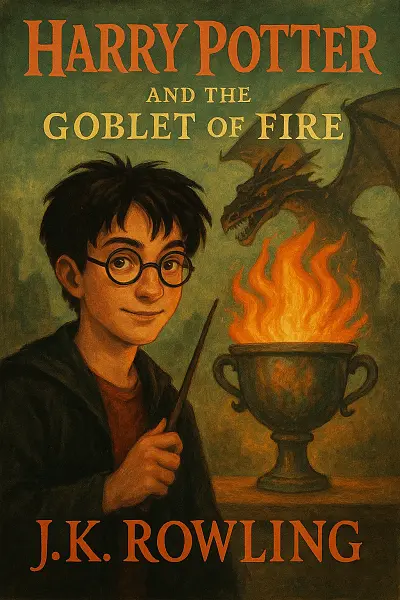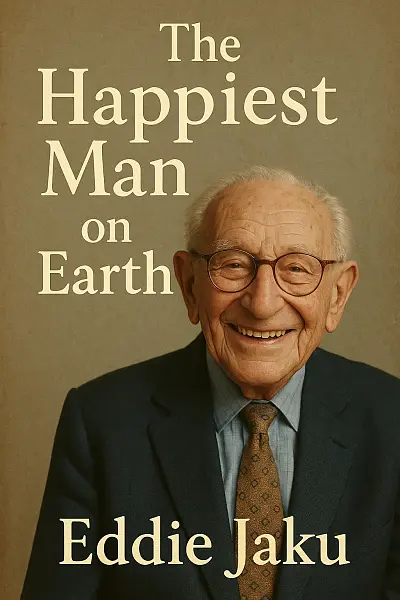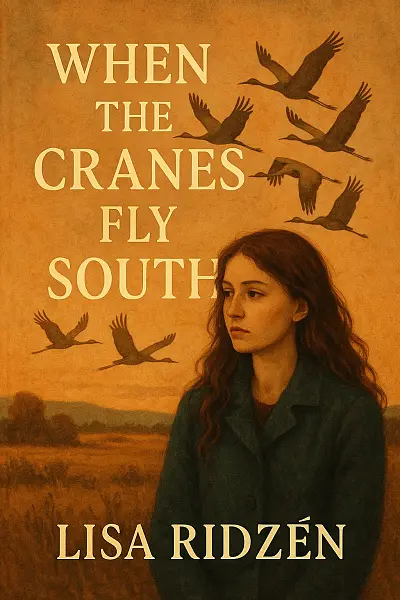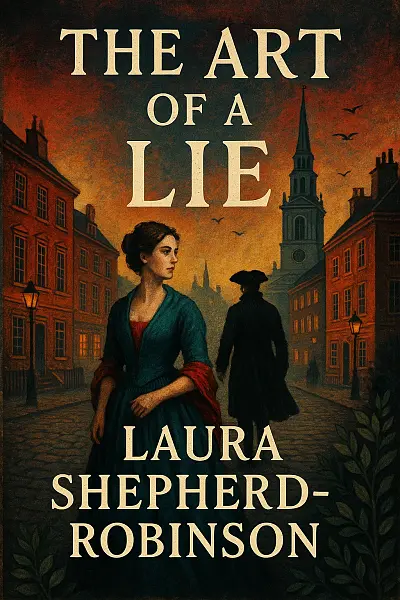
The Art of a Lie
Hannah Cole runs a struggling confectionary shop in bustling 18th-century Piccadilly, determined to carve out a place for herself in a city skeptical of women in business. Everything shifts when her husband is murdered in what seems a random robbery, plunging her life into chaos.
Suddenly, with the notorious Henry Fielding circling her finances and supposed friends revealing sharp edges, Hannah faces a mounting battle for survival and truth. Enter William Devereux—a mysterious ally whose encouragement and the tempting promise of "iced cream" could rescue her shop.
Held together by wit and steel, the story simmers with suspense and secret motives, its textured prose weaving intrigue and yearning. As gossip swirls and stakes rise, it’s deliciously unclear if Hannah and William's connection will save her—or tear everything apart.
""In a world built on shadows, honesty is neither virtue nor vice, but the sharpest tool for survival.""
Let's Break This Down
The Author's Voice
Atmosphere
- Darkly immersive and richly layered
- The book oozes with the claustrophobic tension of Regency-era London, filled with shadows, secrets, and a persistent sense of unease
- Fluidly conjures misty streets, opulent drawing rooms, and grimy corners—expect a palpable chill in the air and a sense of history pressing in
- Emotional weight and moral ambiguity hang heavy, creating a mood that’s both moody and addictive
Prose Style
- Elegant yet accessible
- Shepherd-Robinson blends lush descriptive passages with precise, economical storytelling
- Dialogue snaps with wit and intelligence, often laced with sly irony
- The narration is confident, atmospheric, and never overwrought—expect sentences that flow without sacrificing sharp detail
Pacing
- Measured but never sluggish
- The novel unfolds at a thoughtful, deliberate rhythm—building tension steadily and rewarding patience with unexpected twists
- Some sections lean into introspection, fleshing out backstory and motivation with care, while set pieces and revelations quicken the pulse
- It’s the kind of book where suspense is a slow burn rather than a race, perfect if you savor tension that simmers rather than boils over
Characterization
- Complex, flawed, and deeply human
- Characters leap off the page with distinctive voices, secret wounds, and believable moral dilemmas
- Don’t expect easy heroes or villains—everyone is tinged with shades of grey
- Internal conflict is as gripping as external peril, with relationships nuanced by history and betrayal
Dialogue
- Sharp, witty, and true to the era
- Every exchange feels purposeful—subtext crackles and social maneuvering is layered into even the most casual interactions
- Shepherd-Robinson nails period-appropriate language without letting it bog down momentum
Overall Feel
- A moody, atmospheric, psychologically driven historical mystery
- Readers who love sinking into evocative settings and nuanced emotional landscapes will feel right at home
- You’ll find plenty of surprises, but the real pleasures are in the atmosphere and emotional stakes—this is a story that lingers, leaving a faint trace of candle smoke and regret long after the final page
Key Moments
- Twisty opening scene at the suffragette rally—secrets revealed before the first page turns
- Poison-ink letters sowing chaos in genteel Victorian parlors
- Pure adrenaline: that unforgettable confession through the fog on London Bridge
- Marwood's sharp wit cutting through every tense parlor exchange
- Themes of truth, shame, and justice tangled up in every lie told
- Villains hiding in plain sight—you’ll suspect everyone by page 100
- Atmosphere so vivid, you can practically smell the gas lamps and gin
Plot Summary
The Art of a Lie kicks off in 1830s London as Caroline Corsham, a determined artist and society outsider, investigates the mysterious death of her friend Charlotte after an exhibit at the Royal Academy. Caroline navigates a tangled world of political intrigue, art forgery, and social deception, uncovering that the murder is tied to radical reform movements and hidden identities within elite circles. The tension ramps up as Caroline’s own secrets threaten to unravel, and she confronts betrayals from both allies and family. In a twist, the true murderer is revealed to be Charlotte’s estranged brother, acting out of jealousy and desperation to protect his political ambitions. The novel ends with Caroline achieving some justice for her friend but realizing the cost of truth—and her own place in the world—has changed forever.
Character Analysis
Caroline Corsham is a complex protagonist—fiercely intelligent, daring, and persistently outraged by the restrictions women face in her era. Her personal arc is one of moral reckoning: she starts primarily motivated by friendship but gradually comes to question her own ambitions and the ethical cost of exposing secrets. Charlotte, though murdered early on, remains a vivid presence through flashbacks and the impact her life had on others. The supporting cast—especially the enigmatic artist Lucien and Caroline’s manipulative husband, Robert—demonstrate a broad range of motivations, from self-preservation to ideological zeal, all of which push Caroline to confront her loyalties and sense of self.
Major Themes
Deception versus Truth stands at the heart of the novel as characters navigate London’s glittering veneer and the lies beneath—seen most starkly in the world of art forgery and Caroline’s own personal secrets. The limitations placed on women, especially in the art world and public life, are explored through Caroline’s persistent but often frustrating efforts to be taken seriously. The book also delves into the costs of justice: Caroline’s pursuit of the truth brings her both moral clarity and personal loss, prompting readers to consider whether all lies are equally harmful or sometimes necessary for survival. Loyalty, betrayal, and the blurred lines between them are recurring threads as old alliances break down in the face of new revelations.
Literary Techniques & Style
Shepherd-Robinson’s style blends atmospheric detail with taut suspense, immersing readers in sooty, gaslit London. Her dual timelines interweave the past and present for a slow-reveal structure, keeping the reader guessing while deepening character backstory. Symbolism is woven throughout—paintings, masks, and mirrors recur as metaphors for identity and deception, while sharp, naturalistic dialogue captures the period’s social tensions. The novel’s pacing is brisk, propelled by short chapters and cliffhanger endings, though some readers might find the juggling of plot threads occasionally disorienting.
Historical/Cultural Context
Set in 1830s London, The Art of a Lie unfolds during a period of political agitation (notably the push for the Reform Act) and massive social change. The art world serves as a microcosm for broader societal drama, highlighting issues of class, gender, and shifting values. Author Laura Shepherd-Robinson draws richly on real historical events and the atmosphere of the time, grounding her fictional mystery in authentic settings and social conflicts.
Critical Significance & Impact
This novel has been widely praised for its deft plotting and immersive historical detail, carving out a niche within the historical crime genre by centering the female experience and critique of social norms. Its appeal lies both in its gripping mystery and its thoughtful exploration of Victorian morality, making it a go-to recommendation for fans of cerebral thrillers and lush period fiction. The Art of a Lie feels especially relevant for modern readers grappling with questions about truth, justice, and the costs of challenging the status quo—ensuring its resonance and discussion in classrooms and book clubs alike.

Deception unravels in Georgian London’s glittering world of secrets.
What Readers Are Saying
Right for You If
If you love getting lost in twisty historical mysteries with a dash of darkness, The Art of a Lie is totally up your alley. Fans of intricate whodunits, atmospheric settings, and clever plots, you’re probably going to zip through this one in a weekend. Seriously, if you enjoyed authors like C.J. Sansom, Kate Atkinson, or Robert Galbraith, you'll definitely want to add this to your TBR.
- Obsessed with secret societies, political intrigue, and morally grey characters? You’ll eat this up.
- If you get a kick out of puzzling out convoluted plots where everyone has something to hide, this book’s right in your sweet spot.
- It’s also perfect for anybody craving a richly textured look at Georgian London—think suspense but with historical grit and detail that actually feels authentic.
On the other hand...
- If you prefer your mysteries cozy, gentle, or heartwarming, this one might feel a little too dark and brooding.
- Readers who want fast, action-packed pacing might find the slower, detail-heavy set-up a bit much (it’s more about tension than chases or shootouts).
- Not a big fan of tangled plots or stories where most characters are hiding something? You might end up feeling a bit lost or impatient.
So, in a nutshell: if you’re into clever, layered mysteries steeped in rich historical detail and don’t mind a little moral murkiness along the way, give this one a shot. But if complicated timelines and ambiguous characters are your nemesis, you might want to look elsewhere for your next read.
What You're Getting Into
Set in glittering Regency London, The Art of a Lie plunges you into the world of political intrigue, dark secrets, and hidden desires as a radical abolitionist and a clever society woman are drawn into a murder investigation that threatens their reputations and lives.
With treacherous alliances, high-stakes deception, and the fraught glamour of upper-class ballrooms, every character has something to hide—and every truth comes at a dangerous price.
If you crave twisty mysteries with sharp banter, smart heroines, and rich historical detail, this one totally delivers the suspenseful drama!
Characters You'll Meet
-
Caroline Corsham: Relentlessly determined protagonist drawn into a dangerous investigation after witnessing a murder. Her quest for truth challenges societal constraints and reveals hidden facets of her own courage.
-
Valentine ‘Val’ Mackle: Shrewd and resourceful thief-taker hired by Caroline. He navigates London’s dark underbelly, using both street smarts and moral ambiguity to assist (and sometimes obstruct) the search for justice.
-
Edward “Ned” Lees: Artful and enigmatic figure tied to the victim’s secrets. His fluctuating loyalties and hidden motives keep readers guessing about his true intentions.
-
Lucy Loveless: The victim whose tragic fate sparks the novel’s events. Her secretive past and the mysteries she leaves behind fuel the suspense as Caroline peels back layers of deception.
-
Augustus Corsham: Caroline’s husband, entwined in political intrigues. His distant demeanor and personal struggles create tension at home and add complexity to Caroline’s motivations.
More Like This
If The Art of a Lie hooked you with its twisty secrets and rich historical detail, you’ll probably find yourself just as obsessed with The Thirteenth Tale by Diane Setterfield—both are masterclasses in unreliable narration and the ghostly allure of the past. The layered mysteries in Shepherd-Robinson’s novel can also remind readers of the intricate web Jacqueline Winspear weaves in her Maisie Dobbs series, where complex historical settings become just as vital as the characters’ personal quests for truth and justice. And if visual storytelling is your thing, you’ll spot clear parallels with the BBC series Peaky Blinders: the same brooding London backdrops, shadowy power plays, and characters who are never quite what they seem. These connections create a tantalizing sense of familiarity for lovers of atmospheric suspense and morally ambiguous protagonists, making The Art of a Lie feel like a must-read for anyone craving a clever blend of mystery and period drama.
Critic's Corner
What do we owe the truth, especially in a world constructed so carefully of appearances, rumors, and necessary deception? The Art of a Lie revels in this dilemma, thrusting its heroine into an England where every relationship is shadowed by secrets, social constraints, and the tantalizing peril of desire. Laura Shepherd-Robinson’s historical vision lays bare not only the dangers facing a lone woman but also the myriad small betrayals demanded for survival—inviting us to ask what’s justified when the world asks us to be less than honest.
Shepherd-Robinson’s craft is sharper than ever, brimming with atmospheric detail that never suffocates the narrative drive. Her prose is crisp yet evocative, rendering the fog-choked streets of Piccadilly and the sticky-sweet interiors of Hannah’s shop with almost cinematic clarity. Dialogue—particularly the exchanges with Henry Fielding—crackles with period-accurate wit without lapsing into unwieldy pastiche. The author balances third-person intimacy with moments of sly omniscience, allowing readers access to Hannah’s mounting desperation while keeping the secondary cast tantalizingly opaque. Structural choices—like interludes of courtroom intrigue and culinary obsession—infuse freshness into what could be a conventional historical mystery, while the pacing is deftly modulated. Moments of heartbreak or revelation arise organically, never feeling over-engineered, and subplot threads (from economic sabotage to whispered scandal) enrich rather than clutter.
At its core, The Art of a Lie is a meditation on female agency, moral ambiguity, and the double binds of class and gender. Shepherd-Robinson doesn’t shy from examining the toll oppressive systems take on integrity—Hannah’s struggle isn’t just for justice but for dignity in a world eager to see her fall. The novel interrogates how communities police themselves through gossip and exclusion, and the slow, insidious way that power warps notions of friendship and fair play. Amid all this, the introduction of “iced cream” serves as both a delicious metaphor for reinvention and a sly commentary on innovation as an act of survival. The Art of a Lie resonates with our current anxieties about truth and reputation, but it never loses sight of character-driven stakes, spotlighting the quiet heroism in choosing when to risk honesty.
Readers fond of historical intrigue will recognize echoes of Sarah Waters’ nimble plotting and C.J. Sansom’s psychological acuity, but Shepherd-Robinson carves her own space with prose that avoids melodrama and characters that resist moral tidiness. Fans of The Square of Sevens will find this novel less elaborate in its con-game mechanics but equally absorbing in its depth of emotion and period authenticity. Within the crowded landscape of female-centered historical mysteries, The Art of a Lie stands out for its emotional intelligence and sense of place.
There are minor irritations—a supporting character or two verges on stock villainy, and the final act, while satisfyingly tense, pushes coincidence a bit too far. Still, these are small prices for a story this rich, moving, and slyly subversive. Shepherd-Robinson proves herself a master of historical fiction with heart—one who reminds us how much can hinge on a single lie.
Community Thoughts
I CAN'T STOP THINKING ABOUT LADY MARSDEN, her secrets crawled under my skin and refused to leave. Every page felt like she was watching me, daring me to trust her. Why am I still looking over my shoulder?
I DID NOT EXPECT Eliza’s confrontation in the candlelit study to cut so deep. That one exchange where truth and fiction collided? Still echoes in my head. Shepherd-Robinson writes moments you want to run from but just can’t.
i literally could not stop thinking about Mrs. Marchbanks after closing the book. her secrets crawled into my dreams like shadows with sharp teeth. laura shepherd-robinson, what did you do to my brain?
I CAN'T STOP THINKING ABOUT LADY FLETCHER. Her secrets crawled under my skin and now every shadow feels like a clue. This book hijacked my dreams and I’m weirdly okay with it.
I can’t stop thinking about that scene with Caroline in the candlelit room, her secrets swirling like smoke. Shepherd-Robinson nailed the tension. It’s the kind of moment that sticks, refusing to let you go even after the last page.
Leave Your Review
Local Take
Why It Matters
The Art of a Lie explodes onto the local scene with themes that hit surprisingly close to home. That deep dive into truth, deception, and political intrigue? It instantly calls to mind recent anti-corruption movements and lingering memories of historical power struggles, making the book feel more than a little relevant here.
- Layered secrets and betrayals spark associations with our own cultural narratives about trust, tight-knit communities, and public personas versus private realities.
- The book’s tension between moral duty and personal gain totally aligns with local debates on individual responsibility versus the collective good—a classic cultural tug-of-war.
Plus, Shepherd-Robinson’s atmospheric, character-driven approach—full of twists and slow-burn revelations—really echoes the structure of some beloved homegrown mysteries. At the same time, she challenges the tradition of clear-cut heroes and villains, nudging readers to question inherited loyalties: a move that’s both exhilarating and tricky in a culture where family and reputation run deep.
Food for Thought
Notable Achievement:
The Art of a Lie by Laura Shepherd-Robinson was longlisted for the 2024 Theakston Old Peculier Crime Novel of the Year Award, underscoring its strong impact among contemporary historical crime fiction fans and spotlighting the author's ongoing influence in the genre.
Like what you see? Share it with other readers
